#St.Brigids Day
Explore tagged Tumblr posts
Text
Wk 17, 5th of July, 2024 Research
How to wish upon a scared space?
From the text: Wetlands: Holy Wells and Sacred Springs by Betty Lou Chaika...
When we come upon a spring bubbling out from beneath a tree on a wooded hillside it can seem magical–water emerging from inside the earth.
Springs are a type of wetlands. Are wetlands sacred? On World Wetlands Day, February 2, we are invited to become aware of the immense ecological value of wetlands. Holy wells and sacred springs are wetlands. Many are sacred to St.Brigid, whose feast day of Imbolc is February 1. Imbolc is the Irish festival to welcome Spring back to the land.

Lady's Well, Sheepshead Peninsula
The world-wide loss of over half of wetlands, those wet and fecund habitats, which nourish astounding amounts of biological diversity, is a major reason for the extinction crisis we face. Thankfully, concerned scientists study the needs of wetland plants, animals, and waters, but they so often leave out the intertwined relationship of people and nature, as if we are separate. A basic human need, at least before we were conditioned out of it, is to be creators amidst Creation, lovers amidst a great Love, givers of gratitude to the ever-giving EarthSpirit. The impulse to participate in the universe in our role as conscious beings has given rise to many forms of indigenous spirituality unique to the qualities of the various living environments. In Ireland, with its characteristically wet climate, springs are abundant, and water is honored in the form of thousands of holy wells.
Are wetlands holy? Conservationists are being called to recognize that many peoples the world over regard wetlands as spiritually significant, and, importantly, those wetlands that are regarded as sacred are more likely to be conserved. Science must rejoin spirituality if we are to have any hope of saving life on earth as we know it. Indigenous ecological knowledge is always a sacred knowing. In America our indigenous water defenders are fighting—in a way that fully includes their spiritual understandings and practices—for the life of rivers and wetlands. Indeed, they are rising up forcefully to remind us that water is sacred, that “water is life.” The Celtic people have always honored fresh waters as healing. When we bless and protect water, it blesses and heals us, physically, emotionally, and spiritually.
Holy wells come in as many different forms as the emerging water itself. Many holy wells are rock-enclosed upwellings of water from underground streams. Some may emerge from the side of mountains. Most are clear springs at which water bubbles gently and continuously to the surface. And some boil up powerfully, creating forceful, cold flows in which to courageously immerse feet—or more.
Liminal places, like wetlands, being neither this nor that, neither fully wet nor fully dry, are places where fixed categories are interrupted, so the mind can more easily enter its own halfway point—soul—on the way to spirit. The Irish call these “thin places.”
Rumi says “There is some kiss we want with our whole lives—the touch of spirit on the body.” In pilgrimage, the body is challenged to exert effort in order to serve the soul’s desire to worship at spirit-imbued sites like holy wells.

Offering at Mam Ean, Ireland

Mam Ean Holy Well, Ireland
Another high holy well is a station on the St.Columcille or Columba pilgrimage route. We knew this was a pilgrimage for the deeply devout, but we were unprepared for the unbelievably gigantic cairn of large rocks that devotees have carried all the way up and placed there.

Climbing the St.Columba Pilgrimage Route, Ireland

Oughtmama Holy Well, Ireland
Returning from an effort made in service to soul, even if “unsuccessful,” feels fulfilling, once the sense of frustration passes, that is. All holy wells require some form of circumambulation, circling on foot, three times around sunwise, usually with ritual tasks to perform, a list of prayer sequences special to each well, at stations along the way. The body enjoys making these “rounds.” Some sites even provide a special path to make a mini-pilgrimage around the well. At the lovely holy well of Mary called Tobernault in Sligo there is a path up the hillside to a series of shrines and down around the wellspring and across the creek.

Tobernault Pathway. The Well Is in the Center
From the text: "Significant" hoard of Bronze Age treasure discovered by metal detectorists in Wales by Kerry Breen

Late Bronze Age hoard, AMGUEDDFA CYMRU MUSEUM
Once the hoard is evaluated by the nation's Treasure Valuation Committee, the museum said it is interested in acquiring the items. Adam Gwilt, the principal curator of prehistory at the museum, called the hoard a "significant" find that "adds to the bigger regional picture" of the culture and area during the Bronze Age. Anning also discovered two of the other items that were declared treasures. One, a Roman silver ring fragment, he found in April 2020 while metal detecting. In February 2022, Anning found a medieval silver brooch pin in the same area, again with a metal detector. That pin dates to the 13th or 14th century, the museum said, and the items may be acquired by Wales' Cowbridge & District Museum.

A silver finger-ring fragment, AMGUEDDFA CYMRU MUSEUM
The items, which were found between 2020 and 2022, include a hoard of bronze artifacts such as axes, spearheads, rings and a sword scabbard. The items were discovered by Dr. Peter Anning and Alex Evans in Feb. 2021 in an empty field in Wales where drainage work had been done. The items were dated between 1000 and 800 B.C., and it's likely that they were deliberately buried in the ground by a local community in a ritual ceremony.
From the text: THE HOLY WELLS OF WALES by Howard Huws...

Ffynnon Gybi Llangybi, St Cybi's Well The water from the well flows out of the well building. Photo: Alan Fryer.
It’s an increasingly popular subject, and in Wales we’re fortunate enough to have at least two societies dedicated to the finding, recording and restoration of holy wells. I’m the Chairman of the Welsh one, Cymdeithas Ffynhonnau Cymru, mainly active in the north and west. I enjoy the challenge of researching the subject, and being able to share information and values with others. Whenever I’m on pilgrimage, I look for more wells and sources, and am seldom disappointed.”
Wales is a hilly land facing the prevailing Atlantic winds, thus blessing it with abundant rain and fresh waters. Our country is equally saturated with a rich inheritance of belief and practice, so one should not be surprised to learn that holy wells are numerous and prominent features of the geographical and spiritual landscape. Even a strict definition of the term “holy well” allows there to be several hundred here, and diligent research is bringing even more to light once dismissed as objects of superstition, they are now the subject of increasing interest.
Fresh water is essential for earthly existence, but heavy. Carrying it in quantity requires considerable time and effort, and any settlement, however temporary, must have a dependable supply close at hand. Our ancestors particularly valued reliable, copious wells and springs untainted in smell and taste, and free of ill-effects.
We’re on safer ground in stating that the archaeological record indicates a significant climatic deterioration during the Mid-Bronze Age, about 1100–1000 BC. This coincides with an increased tendency to place items of value in lakes, rivers and bogs. It’s tempting to conjecture that these were offerings to spirits or gods, as the old sacred network of stone circles, henges and pits was abandoned in favour of the watery portals of an otherworld whose forces were obviously gaining the upper hand on those of sunny sky and dry earth. Such relics may, however, have been as much (or more) a means of marking territorial boundaries in an age of heightened conflict, as agricultural land became increasingly waterlogged and unproductive.
This impulse to place valuables in water was strong enough to cause the deposition of large amounts, and the building of elaborate wooden piers to facilitate the practice. All manner of gear found its way into the waters, but the most popular, by far, were swords, spearheads and axe heads, very often bent, broken or otherwise rendered useless to man beforehand. This wasn’t scrap metal: the objects had been in good condition, and even fresh from the mould, before being deliberately spoilt and deposited. So why throw them away? Possibly as a rite of devotion, and a means of removing surplus bronze from circulation. This would increase its scarcity, maintain the value of what remained, and thus confirm and boost the social status of whoever could afford to throw it away: members of a warrior caste, judging by the predominance of weapons. Our culture, alas, is still one which lends prestige to such conspicuously unproductive use of resources.
They drew the line at the indigenous habit of drowning victims in bogs, and sensibly refrained from throwing away useful weaponry: but did offer water-nymphs and goddesses coins and jewellery, and present written requests and curses. As for personal standing in the community, erecting a stone shrine or temple was obviously more permanent and impressive than some wasteful native potlach.

St. Seirol's cell and well, Cymry
Accumulations of white pebbles, such as are found at pre-Christian sites, have also been found at Welsh holy wells. They’re undeniably striking, and have been collected and used for ornament since we dwelt in caves: but again, there’s no evidence for their being cast into wells before the mediaeval period, and the only reason for that may have been that they were thought to look attractive. We to this day crown walls and gateposts with white quartz, and strew it on graves, because it looks bright and clean, not for any other reason.
One also finds wells whose waters were said to cure and safeguard livestock, including cattle, sheep and horses. Others are now simply regarded as “lucky” or wholesome; but without a specifically Christian dedication, they’re no longer thought of as being holy. It may be that some were once so dedicated, but that the spiritual tradition was broken or forgotten in the confusion of the Protestant Reformation and the subsequent centuries of discouragement and neglect.
0 notes
Text
Celtic Women #650
We’re highlighting some of the amazing women in Celtic music on this Irish & Celtic Music Podcast #650.
Eimear Arkins, Mary - Kate Spring Lee, Sassenach, Bonhomme Setter, Vicki Swan & Jonny Dyer, Mary Beth Carty, Matt & Shannon Heaton, Rover's Way, Hanneke Cassel, Celtic Woman, Katherine Nagy, Kathryn Tickell & The Darkening, Derina Harvey Band, Mànran
GET CELTIC MUSIC NEWS IN YOUR INBOX
The Celtic Music Magazine is a quick and easy way to plug yourself into more great Celtic culture. Enjoy seven weekly news items for Celtic music and culture online. Subscribe now and get 34 Celtic MP3s for Free.
VOTE IN THE CELTIC TOP 20 FOR 2024
This is our way of finding the best songs and artists each year. You can vote for as many songs and tunes that inspire you in each episode. Your vote helps me create next year's Best Celtic music of 2024 episode. You have just three weeks to vote this year. Vote Now!
You can follow our playlist on Spotify to listen to those top voted tracks as they are added every 2 - 3 weeks. It also makes it easier for you to add these artists to your own playlists. You can also check out our Irish & Celtic Music Videos
THIS WEEK IN CELTIC MUSIC
0:02 - Intro: Debby Regan
0:18 - Eimear Arkins "She's At It Again / Tune For Tom (Jigs)" from Here & There Eimear Arkins: fiddle
4:00 - WELCOME
6:15 - Mary - Kate Spring Lee "Kusnacht/St.Brigid's Day" from Tunes in the Morning Mary - Kate Spring Lee: harp
12:18 - Sassenach "Siúbhán Ní Dhuibhir" from Passages Jane Critchlow: lead and harmony vocals, bodhrán, percussion Susan Palmer: harp, harmony vocals Laurence Beaudry: violin, viola, harmony vocals Marie - Claude Simard: cello, harmony vocals
15:29 - Bonhomme Setter "Slide From Grace" from Colors of Time SYLVAIN LABEGE | flute . whistle MARIE - NOËLLE HARVEY | violin . viola
20:08 - Vicki Swan & Jonny Dyer "John Lover" from Twelve Months & A Day Vicki Swan: nyckelharpa, background vocals
24:37 - FEEDBACK
27:43 - Mary Beth Carty "Voilà le printemps" from Crossing the Causeway Mary Beth Carty: accordion, guitar, bass, jaw harp, bones, triangle, shakers, tambourine, cow - bells, and washboard, vocals
31:36 - Matt & Shannon Heaton "Last Days of Fourth Grade/Against the Grain/Jig for Tim (waltz and jigs)" from Whirring Wings Shannon Heaton: flute
36:45 - Rover's Way "The Journey" from The Journey Keira Young: Penny whistle, bodhran, vocals
39:19 - Hanneke Cassel "Religulous / Patience" from Dot the Dragon's Eyes Hanneke Cassel: fiddle
44:08 - Olivia Bradley “Molly Malone” from Misty Morning Shore
46:44 - THANKS
50:15 - Celtic Woman "A Stór Mo Chroí" from 20th Anniversary Tara McNeil: violin, harp, vocals Mairéad Carlin: vocals Muirgen O’Mahony: vocals Emma Warren: vocals
55:12 - Katherine Nagy "Jimmy's Dance" from Single Katherine Nagy: guitar, vocals
58:45 - Kathryn Tickell & The Darkening "Just Stop & Eat The Roses" from Cloud Horizons Kathryn Tickell (Northumbrian smallpipes, fiddle, vocals) Amy Thatcher (accordion, synth, clogs, vocals), Josie Duncan from the Isle of Lewis (vocals, clarsach).
1:02:34 - Derina Harvey Band "Stopped or Gone" from Waves of Home Derina Harvey: guitar, vocals Jess Blenis (violin)
1:05:33 - CLOSING
1:07:50 - Mànran "Briogais" from Ùrar Kim Carnie: vocals
1:10:39 - CREDITS
The Irish & Celtic Music Podcast was produced by Marc Gunn, The Celtfather and our Patrons on Patreon. The show was edited by Mitchell Petersen with Graphics by Miranda Nelson Designs. Visit our website to follow the show. You’ll find links to all of the artists played in this episode.
Todd Wiley is the editor of the Celtic Music Magazine. Subscribe to get 34 Celtic MP3s for Free. Plus, you’ll get 7 weekly news items about what’s happening with Celtic music and culture online. Best of all, you will connect with your Celtic heritage.
Please tell one friend about this podcast. Word of mouth is the absolute best way to support any creative endeavor.
Finally, remember. Reduce, reuse, recycle, and think about how you can make a positive impact on your environment.
Promote Celtic culture through music at http://celticmusicpodcast.com/.
WELCOME THE IRISH & CELTIC MUSIC PODCAST
* Helping you celebrate Celtic culture through music. I am Marc Gunn.
This podcast is here to build a diverse Celtic community and help the incredible artists who so generously share their music with you. If you hear music you love, please email artists to let them know you heard them on the Irish and Celtic Music Podcast. Musicians depend on your generosity to keep making music. So please find a way to support them. Buy a CD, Album Pin, Shirt, Digital Download, or join their communities on Patreon.
You can find a link to all of the artists in the shownotes, along with show times, when you visit our website at celticmusicpodcast.com.
If you are a Celtic musician or in a Celtic band, then please submit your band to be played on the podcast. You don’t have to send in music or an EPK. You will get a free eBook called Celtic Musicians Guide to Digital Music and learn how to follow the podcast. It’s 100% free. Just email Email follow@bestcelticmusic and of course, listeners can learn how to subscribe to the podcast and get a free music - only episode.
THANK YOU PATRONS OF THE PODCAST!
You are amazing. It is because of your generosity that you get to hear so much great Celtic music each and every week.
Your kindness pays for our engineer, graphic designer, Celtic Music Magazine editor, promotion of the podcast, and allows me to buy the music I play here. It also pays for my time creating the show each and every week.
As a patron, you get music - only episodes before regular listeners, vote in the Celtic Top 20, stand - alone stories, and you get a private feed to listen to the show. All that for as little as $1 per episode.
A special thanks to our new and continued Celtic Legends: Bill Mandeville, Marti Meyers, Brenda, Karen DM Harris, Emma Bartholomew, Dan mcDade, Carol Baril, Miranda Nelson, Nancie Barnett, Kevin Long, Gary R Hook, Lynda MacNeil, Kelly Garrod, Annie Lorkowski, Shawn Cali
HERE IS YOUR THREE STEP PLAN TO SUPPORT THE PODCAST
Go to our Patreon page.
Decide how much you want to pledge every week, $1, $5, $25. Make sure to cap how much you want to spend per month.
Keep listening to the Irish & Celtic Music Podcast to celebrate Celtic culture through music.
You can become a generous Patron of the Podcast on Patreon at SongHenge.com.
TRAVEL WITH CELTIC INVASION VACATIONS
Every year, I take a small group of Celtic music fans on the relaxing adventure of a lifetime. We don't see everything. Instead, we stay in one area. We get to know the region through its culture, history, and legends. You can join us with an auditory and visual adventure through podcasts and videos. Learn more about the invasion at http://celticinvasion.com/ #celticmusic #irishmusic #celticmusicpodcast
I WANT YOUR FEEDBACK
What are you doing today while listening to the podcast? Please email me. I’d love to see a picture of what you're doing while listening or of a band that you saw recently.
Email me at follow@bestcelticmusic.
Dan Vaughn emailed some photos: "Hello! My name is Dan Vaughn, I am 1 of 3 members of the band Sorcha and I'm reaching out to you to try to make an appearance on your podcast! We are about to launch our new EP next week titled Stomp the Floor and we're very very excited about it. I'm going to attach the tracks to this email along with some pictures. Hope to hear from you soon!"
Steve Bradley emailed a photo: "Hi Marc, Greetings from Atlanta! Love the podcast, and like to listen while walking my dog, Augie. Here's a pic of him today as we were listening to episode #648! My favorite artist is of course my daughter, Olivia Bradley, and we're heading up to Calhoun tonight to hear her perform with Celtic Angels at the GEM Theatre. Thanks for all you do in highlighting great music each week and supporting the artists who produce it!"
Check out this episode!
0 notes
Text
The answer is syncretism!
I am Italian and I live in the countryside and in my region, Catholics had a very difficult time to make people convert, so, especially to Pagans (people from the countryside, as the initial meaning, not the insult that means polytheist, now) this new religion wasn't appealing.
I mean, we had our Gods and spirits, stranger danger, right?
So, slowly, who converted (and the early church) found a way to syncretize the "old" Gods with the "new" one: Brighid becoming St.Brigid was also a companion of Mary, guiding her and little Jesus to be presented as the temple.
This became so widespread (and popular, and I find it super sweet, as a polytheist) that people started a tradition: on the Candlemas (called Candelora in Italy) people would take their candles to be blessed in their local church.
This mid-way between Polytheism and Catholicism give way to the many syncretic and folk practices that are still in use and very popular on ours days too.
Little curiosity: the day after Candelora is St.Blaise and the tradition wants that, since the Saint is the protector of the throat, eating the last Panettone will cure your throat problems too!
I wanted to share it because I do really love Mary and her story, even if I am not a Catholic anymore!
I wrote a post trying to figure out why on earth some Pagans & Witches refer to Imbolc (an Irish spring agricultural holiday associated with St Brigid, a potential Christianization of the Goddess Brigid/Bríg) as Candlemas, the completely Christian holiday celebrating The Purification of Mary & Presentation of Jesus at The Temple— which originated in the eastern part of the Roman Empire (which the only "pagan" aspect was it competing with Roman Lupercalia for celebrants).
Many pagan & witch spaces online have a constant disdain for Christianity thus I could not wrap my head around them using such an important point of Jesus' & Mary's life as one of their festivals/'sabbats'.... then, after writing a bunch of stuff, I stumbled onto the answer on Wikipedia's Wheel of The Year page, which has citations for its claims:
Margaret Murray (very early 20th century scholar) in her now discredited witch-cult hypothesis said that the Scottish "witch" Issobell Smyth in 1661 confessed to attending meetings for witches on the cross quarter days included Candlemas. Robert Graves (oh how I loathe you ehem I mean: poet folklorist), mentioned that Candlemas was part of the 8 ancient British agricultural festivals. And Doreen Valiente ("The Mother of Wicca") included Candlemas in her list of Greater Sabbat Fire Festivals, while also listing "Gaelic counterparts," in this case Imbolc.
Sigh.
Early (read: 19th-20th century) paganism and witchcraft, or scholarly work about it, really was just: put every claim regardless of accuracy from any culture in this jar, shake it up real good, see what pops out from the mix, then pretend its historically attested to and traditional despite any and all evidence.
Also whatever Wikipedia writer wrote this, I appreciate your sassiness ... even if it was unintentional:
Due to early Wicca's influence on modern paganism and the syncretic adoption of Anglo-Saxon and Celtic motifs, the most commonly used English festival names for the Wheel of the Year tend to be the Celtic ones introduced by Gardner and the mostly Germanic-derived names introduced by Kelly, regardless whether the celebrations are based on those cultures.
EDIT: To be clear, not all neo/pagans, witches, wiccans, occultists, people-who-use-wheel-of-year are anti-Christian! I'm not trying to say that. But as a worshipper of Mary now, I notice it more and more. Nor am I saying all those people follow Murray/Grave/Valiente blindly but published works and trusted blogs often seem to. This is simply an observation, I've taken notice of, its not the entire communities.
43 notes
·
View notes
Text
Ways to Celebrate St. Brigit's Day/Imbolc

Celebrations last from 2/1 through 2/2



Tell us how you celebrate and tag @fromashandwax if you use our suggestions.
Read more about St. Brigit's Day/ Imbolc on our website link in bio.
#imbolc#St.Brigids Day#Brigid#pagan holidays#magick#pagans#pittsburgh pagans#burghwitches#pagansofintagram#witchesofinstgram#witchcraft#eclecticwitches
3 notes
·
View notes
Text

About this mural: "We were thrilled to be involved in the development of the new Brigid of Faughart Mural created in Bridge Street, Dundalk as part of the SEEK Visual Arts Festival in August 2020. The mural was created by the wonderfully talented artist Friz, who is based in Belfast and who managed to incorporate so many aspects of Brigid as both Christian Saint and Pre-Christian Goddess in this exciting new artwork. The mural is located in Bridge Street in Dundalk, which is the street that local people would have passed along, when walking out to Faughart for the annual St.Brigid’s Day celebrations – a very fitting location indeed. We wish to thank all involved in organising the fantastic SEEK art festival in Dundalk this year! Why not pay Brigid a visit next time you are in the area."
4 notes
·
View notes
Text
2023年2月11日朝6:30、コーク市内のフラットを出る。約2時間半、電車を乗り継ぎ、キルデア州キルデア(Kildare, Country Kildare)を目指す。

朝8時17分、乗り換えのサーリス(Thurles)駅プラットフォーム。日照時間がまだまだ短く、朝8時過ぎでも明け方の気配が残る
雨上がりの生臭い都市のにおいと、町外れから風にのって運ばれてくる野原のわずかなにおいが混ざりあって、日の出前の暗闇がつつむ冷たい空気に溶けている。
サマータイムのはじまりまで残り一ヶ月半、日中の陽が短く、曇天と雨の日ばかりが続くアイルランドの冬の厳しさは、南米や南ヨーロッパ出身の友人たちのメンタルを目に見えて明らかにすり減らしていた。
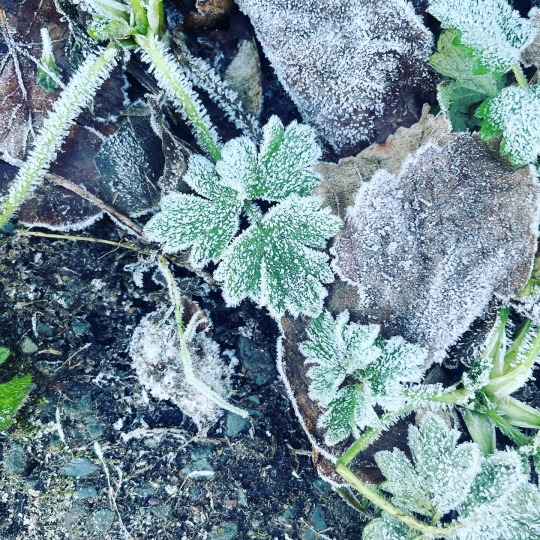
霜が降りたフィッツジェラルドズパーク(Fitzgerald's Park, Cork)、リー川(River Lee)沿いのキンポウゲの葉
「あなたは日本でも北の方の出身だから、こういう冬の気候に慣れているんでしょ?」と、げっそりした表情の移民の友人たちが訊ねてくるたびに「アイルランドにおける英語の『冬』と、日本語の『冬』は、その言葉に含まれているバックグラウンドが違う、このふたつは完全に違う季節だと思う」と答えた。
彼らが「冬」と呼ぶ、11月初旬から3月後半あたりまで、わたしたちのイメージする冬らしい冬の日もあるにはあったけれど、それはせいぜい1ヶ月半くらい。あとのおおよそ4ヶ月間は、気温一桁台から二桁台前半あたりをうろうろする。メキシコ湾からアイルランドとイギリスに届く暖流の影響で、振り続ける雨は雪になること無く、その影響で湿度が下がらない。体感は寒いのに、大気は霧と湿度に包まれてなんとなくじめじめしている。
要するに、冬の厳しさの質が全く違う。
東北の冬が、雪という抗いようのない大きな重量を持った物体に対して、歯を食いしばりぐっと耐え忍ぶようなイメージなら、アイルランドの冬は、浴室に生えるカビのように毎日少しずつ心の中のしんどさの領土を広げていく。

コーク郊外、冬はよく町が霧に包まれる
春が来る。
2月1日はケルトの暦の春分の日、ゲール語でインボルク(Imbolc)。
暦の上での春と、体感としての春��おおよそ1ヶ月の時間が空くこと、そしてその到来がそこに住む人々にとって他の季節のどれよりも特別であることは東北と同じだ。
前回記事のハグ・オブ・ベアラ(Hag of Beara)についての文献を調べていたときに何度も目にしたブリジッド(Brigid)の名前は、ケルト神話に登場する存在だった。
なので当然、2月1日の聖ブリジッドの日(St. Brigid’s Day)の日や、その名前を冠して2023年から公式にアイルランドの祝日になった2月の第一月曜日も、それに関連する日だと思い込んでいたがどうやら違うらしかった。
聖ブリジッド(St. Brigid)は現在の北アイルランドとの国境近く、ラウス州フォアハート(Faughart, Country Louth)に生まれ、5世紀から6世紀にかけて実在していたとされるアイルランド人の修道女だ。
幼い頃から貧しい人々に施しを与え、アイルランドの守護聖人である聖パトリックによって洗礼を受けたあと、各地で教会や修道院、アートスクールまで設立したと言われている。
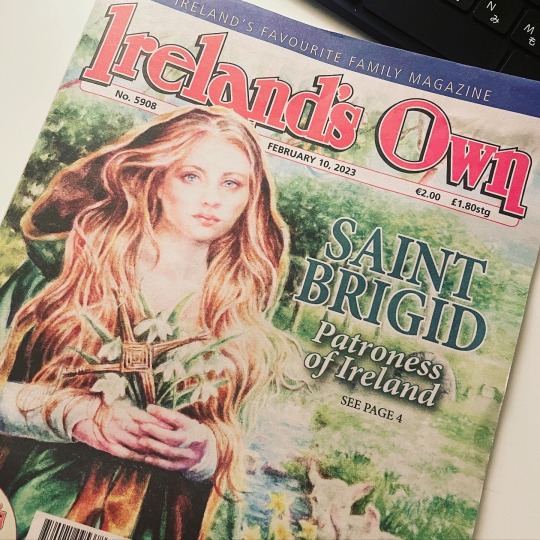
1902年から続く雑誌 Ireland’s Own の表紙の聖ブリジッド、手には彼女の信仰の象徴の十字架の藁細工
彼女に関して興味深い点がふたつある。
ひとつは、彼女が実在したことを確実に証明できる文献が残っていないこと。
そしてふたつめは、前述の通り全く同じ名前のケルト神話の女神が存在することだ。
日本に五穀豊穣や学業成就を祈るためのモチーフとしての神々があるように、キリスト教圏の聖人にもその多くに守護の対象がある。聖ブリジッドの守護対象は家畜、詩、歌、鍛冶、病気からの回復など、周知されているものだけでも非常に手広い。
そしてそれらの守護は、女神ブリジッドの守護するものと同じだ。
普遍的な祈りである「病気からの回復」は、アイルランドにおいて井戸や湧き水と関連付けられることが多い。古くはドルイドの信仰の対象であり、地下から湧き上がる水は癒しや命の源とみなされ、アイルランド国内に約3000ある「聖なる井戸」の内の少なくとも10の井戸がブリジッドと紐付いて周知されている。
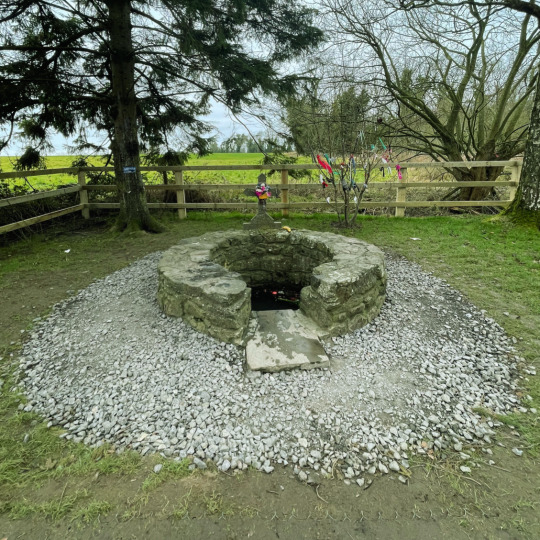
聖ブリジッドの泉の井戸、井戸の水自体は正直あまり綺麗な水質には見えなかった
彼女が修道院と教会を建てたあとそこに没したとされる町、キルデアの町外れには、それらを巡礼する人々のために用意された聖ブリジッドの泉(St Brigids Garden Well)がある。
もともとの小川の曲線に沿って整備されたと思われるその小さな公園には、聖キルデアの銅像が経ち、彼女に対する崇拝の象徴であるイグサや藁で編まれた十字架のモチーフが散見される。
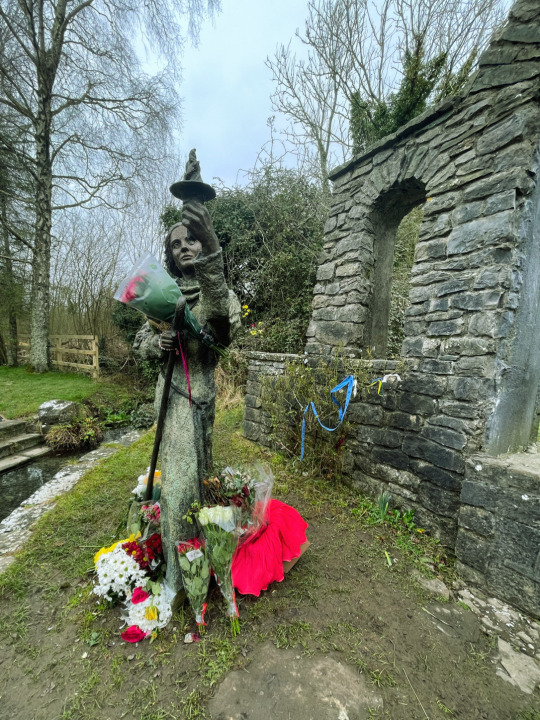
聖ブリジッド像、聖ブリジッドの日から5日後だったこともあり供えてあった花はすべて瑞々しい
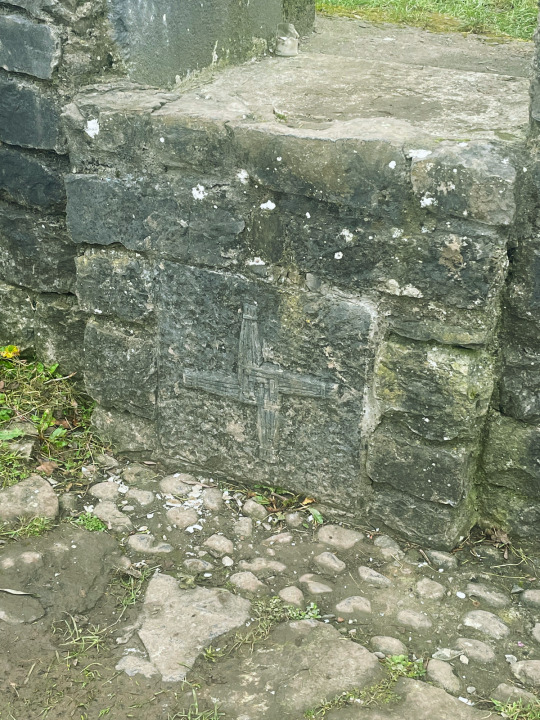
外壁に刻まれた聖ブリジッドの十字架(St.Brigid’s Crosses)モチーフの彫刻。2月1日にこの十字架を玄関に飾るとブリジッドの守護が受けられるという信仰がアイルランドにおいて広く分布する
その周囲や周りの木々、公園の奥に位置する井戸の近辺には多くの供え物が並ぶ。供え物の多くは治癒を望む体のパーツにまつわるものであるらしく、パンデミック後ということもあってかマスク(文脈を知らず一見すると捨てられたマスクのゴミに見える)が目立った。
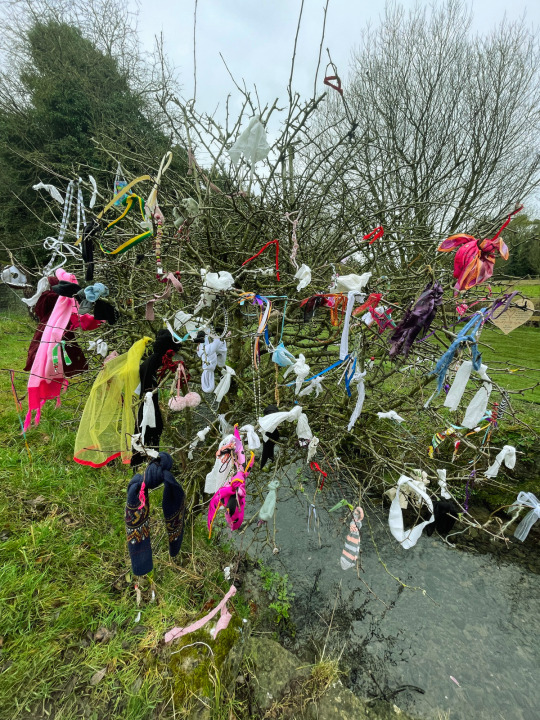
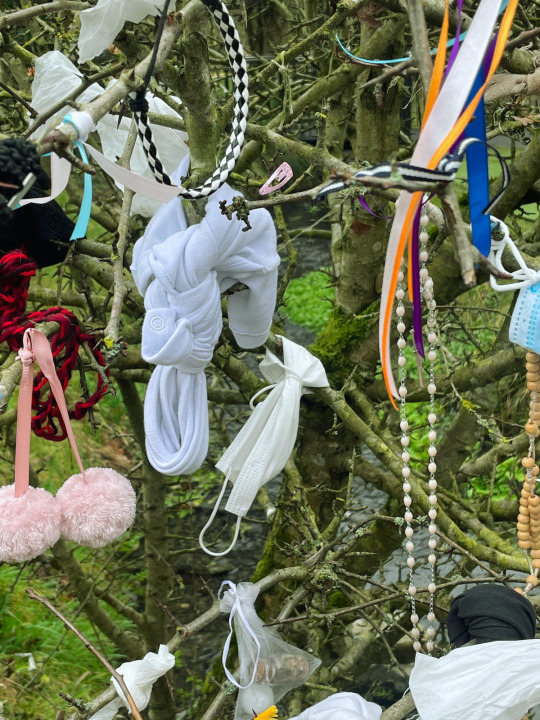
ストッキング、マスク、靴紐、靴下、スカーフ、ネックレス、供え物は様々。木から供物が落ちると祈った箇所が加護を受け、病気や外傷が治癒すると信じられている
町外れに位置するにも関わらず、絶えず入れ替わり数名の人が訪れる。
録音レコーダーをまわしながら、来訪者が途切れたタイミングで公園の全景を眺める。澄んだ小川が風を運び、もとの地形にも配慮されデザインされたと思われる、心地の良い公園である。にも関わらず、なんだか妙な感じがした。
公園の奥にある井戸と、入り口付近を流れる小川が繋がっていないのだ。地下で繋がっているのかもしれないと思い小川の上流を視線でたどっても、井戸とは90度逆の方向だ。上流は茂みの奥へと続き、その先は見えなかった。
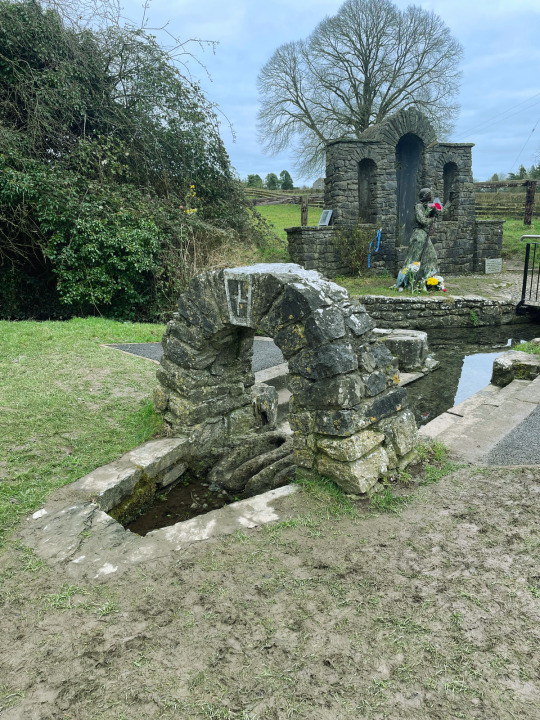
公園全景。撮影地点の背後に井戸がある。小川は写真左奥の茂みの方から水が流れて来ている
録音を終えると、キルデアの中心部に向かう。
中心部といっても、人口9000人に満たない小さな町だ。もとは数えられるほどのパブとカフェ、そして聖ブリジッドが設立したといわれる中規模の教会がある比較的静かな町だったが、2007年にオ��プンした大型アウトレットモールには隣県である首都ダブリンからも大型バスが乗り入れる。
土曜日の昼下がりに町を歩くほとんどの人が、有名ブランドのショップバッグを持ち、駅の方角へと歩いていく。
中心部にやって来たのは聖ブリジッド大聖堂(St Brigid’s Cathedral)に行くためだった。だが、この日に限ってメンテナンスのために敷地全体が閉鎖されていた。
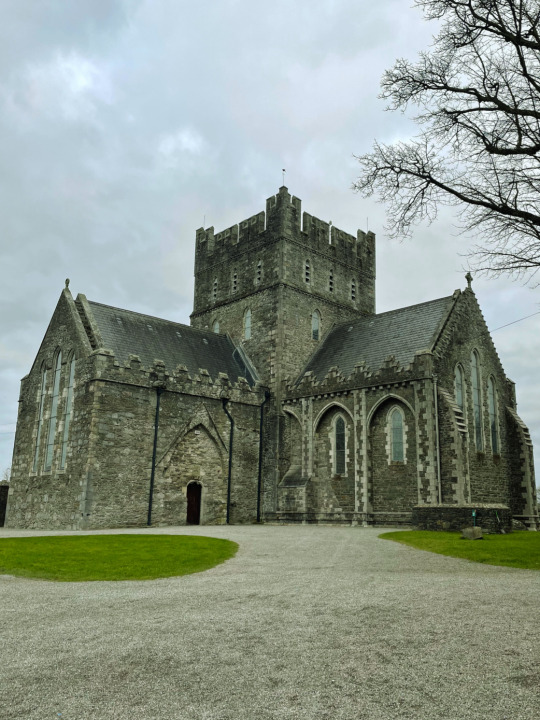
聖ブリジッド大聖堂、閉じられたメインエントランスのフェンスに手をつっこんで撮った写真……
アイリッシュ・ナショナル・スタッド&ガーデンズ(Irish National Stud & Gardens)に向かった。
時間が余ったらついでに行けたらいいかな、と思っていた場所だ。
競走馬の繁殖とトレーニングの場として20世紀初頭に設立され、今では市民に親しまれる広域公園としても機能するこの場所には日本庭園がある。

1906年、ロンドンで日本趣味の骨董品店を経営し、自身も骨董商だった Tassa Eida (日本名: 飯田三郎)は、日本庭園をつくるためにキルデアに派遣され、その後の4年間を彼の息子 Minoru と共に造園に従事する。
(彼らの詳細については こちら と こちら の記事が詳しい、どちらも素晴らしくリサーチされたポスト)

手入れの行き届いた枯山水
19世紀後半から20世紀初頭にかけてジャポニズム、つまり「日本っぽいもの」がヨーロッパで流行ると、貴族たちはこぞって「日本っぽい建築」や「日本っぽい庭園」を作りたがった。
ただし、やはりそれは「日本っぽいもの」の域を出ないものが多く、日本で生まれ育った人間が見ると、形容し難い、ちょっとした居心地の悪さのようなものを覚えるようなものが多い。
そういう類のものだろうとあまり期待せずに訪れると、良い意味でその期待を裏切られる。
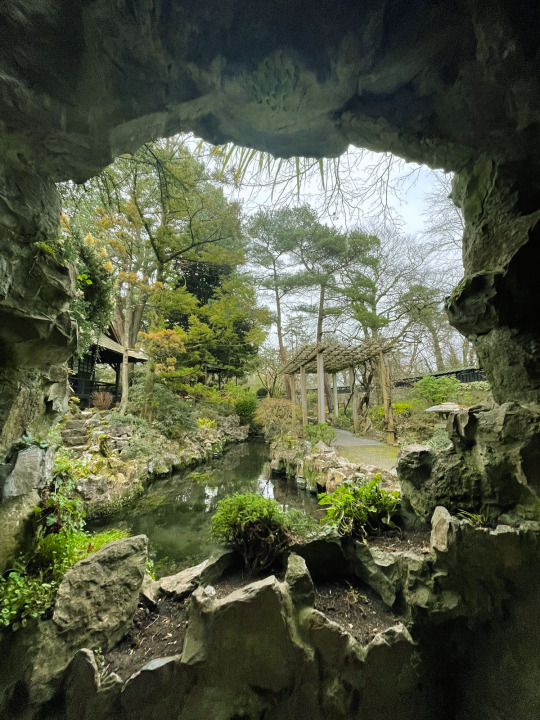
庭園の動線、ちょうどまんなかあたりにある洞窟?からの景色。右にあるのは藤棚で春にはきれいに藤の花が咲くらしい
清らかな水が美しい動線で引かれ、人が生まれてから死ぬまでを表現したその庭園は、当時イギリスで流行したエドワード様式建築の影響を受けて少しだけ華美ではあるものの、正真正銘の日本庭園だった。

庭園の石灯籠によじ登っていた鬼。庭園にある多くの植物やオブジェクトが日本から輸入したものだが、たまにこういう西のものとも東のものとも分からないモチーフも見かけて興味深かった
町の中心部に戻ると、帰路の電車の出発まで1時間弱の時間があった。
少し散策したあと、聖ブリジッド大聖堂に戻ってくる。
地域の人だけが使う入り口とかあってそこから入れたりしないかな……などと不届きなことを考えて外壁の周りをうろついたが、それらしきものは見つからなかった。

入り口を探っているときに外壁から見えたラウンドタワー、実際に登れるものとしてはアイルランド国内でいちばん高いらしい
しかたなくキルデア駅に向かう。
プラットフォームの椅子に座って電車を待っていると知らない女性に、どこから来たのか、と声をかけられた。
薄暗いプラットフォームで目をこらすと、大聖堂に戻る前に一瞬だけ立ち寄った、メインストリートから少し外れた場所にあった雑貨屋の店員だった。
日本から来たこと、リサーチに関すること、井戸とスタッドガーデンの方には行って、教会にどうにか入れないか模索したが結局入れなかったことを拙い英語で説明する。
すると「どっちの井戸に行ったの?」と訊ねられた。
聞き間違いかと思い、どういう意味ですか?と返すと、彼女が説明してくれた内容はこうだった。
ブリジッドの井戸はふたつあって、ひとつはおそらくあなたが行った聖ブリジッドの泉、 聖人の方のブリジッドを祀ってるところ。地元民にとってはずっと特別な場所だったけど、パンデミック中にきれいに整備されて、観光客が来たり滞在したりが以前よりも更に容易になった。
もうひとつあるのが、Wayside Well(日本語直訳: 道端の井戸)と呼ばれている場所。こっちがキリスト教伝来前のドルイド(ケルト人たちの信仰における祭司)のブリジッドを祀っていると言われている。スタッドガーデンの駐車場からすぐそばの、とても素朴な井戸で、観光客はまず行かない。
そして、聖ブリジッドの泉の公園を流れる水は、Wayside Wellが源泉。
そう、この話を初めて聞いたとき、わたしもとてもおもしろいと思った。
地味で、ほぼ地元民しか知らない、古代ブリジッドの方から湧き出た水が、キリスト教のブリジッドの方に流れていって、そしてその公園の方が立派に整備されていて、人がたくさん来る。歴史が辿ったストーリーと水の流れが同じなんて、ちょっとロマンチックだよね。
そして、あなたの旅のことも同じようにロマンチックに感じる。
日本庭園に行ったんだよね?
あそこを流れる小川の水も、同じWayside Wellから引いた水だよ。

スタッドガーデンの日本庭園に流れる小川
水の情報記憶に関する文章を読んだことがある。
スプーン1杯の水が1TB分の情報を記録できる、という科学研究だ。
信仰が人々の普遍的な祈りを運ぶ船だと考えたとき、わたしたちは船を替えても、変わらず同じ水の上に浮かぶ。
あれこれ考えて右往左往するよりも、もっと単純に、すべては最初から土地とそこを流れる水にメモリーされていて、わたしたちはきっと、そのぼんやりとした断片にただ触れることだけができるのかもしれない。
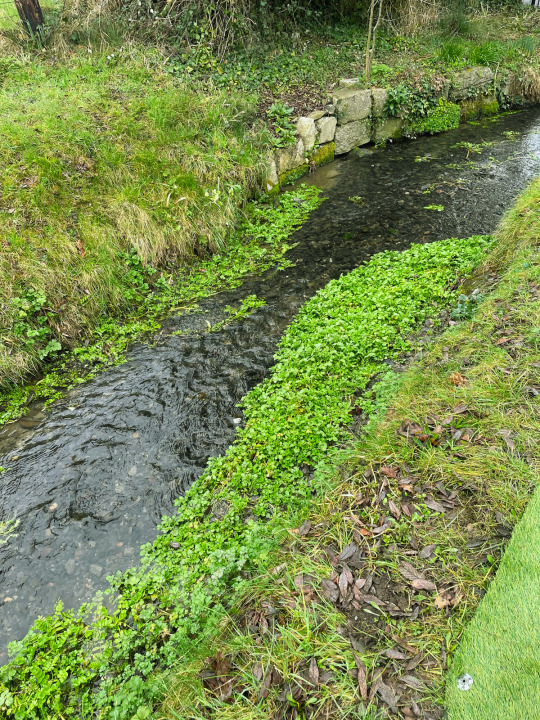
聖ブリジッドの泉公園を流れる小川。水がとても綺麗でクレソン?が群生していた
ふたつの井戸の話にあまりにも驚いて「そんな情報、どこにも書いてなくて全然知らなかった、道端の井戸(Wayside Well)の方にも行くべきだった」とわたしが言うと、彼女は微笑みながらこう言った。
「また来ればいいよ、水が止まることはきっとないからね」
3 notes
·
View notes
Text
Finally doing a post about the Goddess Brigid, but I’m doing this in a different format cuz there’s A Lot to cover for her
Who is Brigid: Brigid (or Bríg in Old Irish) is the daughter of the Dagda and, supposedly, a poet, though it has been argued that her mother may have been Danu, a powerful river Goddess and the mother-goddess of the Tuatha De. Her name isn’t actually a name, but rather a title that means “Exalted One.” We have no real clue what her True Name might’ve been
Brigid is also where the word “bride” is derived and her soldiers were called “brigands” so you can thank her for that, too
What was she Goddess of: Boy howdy is this a list! Okay so Brigid is a Goddess full of contradictions. She’s the Goddess of Fertility, Spring, Life, The Dawn, Poetry, Blacksmiths, Motherhood and Childbirth, Healers, Wells and Waterways, Fire, The Hearth, Water, Serenity, Passion, Invention and a patron of Warfare.
Appearance: all we know of Brigid’s appearance is that she was “flame-haired” and appeared as either a Maiden or Mother, wearing a cloak made of literal sunbeams. Badass
Domains: Her domain over fertility and motherhood even extended towards animals, and she was even a protector of domesticated pets. Her own pets included; Fe and Men, two oxen who lend their names to Mag Femen, a field in County Kildare; Torc Triath, the “king of boars” which appeared in Arthurian legend; and Cirb, a powerful ram and the king of sheep
Because she was a goddess of poetry, passion and invention, many Irish writers, even well into the Christian Era, credited her as their inspiration, and she inspired craftsmen of all trades.
Brigid is believed to have been a Triple Deity. Unlike many Triple Deities, however, all of her “aspects” shared her name/title, meaning she was capable of having multiple husbands, parents and children without causing direct contradiction in the mythos
She holds dominion over both rivers and wells. You’ll know which ones cuz they’re all named after her. (We’ll get back to this in a moment)
Imbolc: Brigid’s festival of “Imbolc” is held on February 1st and marks the beginning of the Irish year. Offerings of food and silver coins and trinkets were brought to her rivers and wells, and many who came to her for her blessings asked for healing, protection and/or inspiration
Keening: when Brigid’s son, Ruadán, was killed in the war against the Fomorians, Brigid rushed out to him to mourn him and from her lips came a lament known as “keening.” This was the first time that sorrow had been felt in Ireland and it spawned a tradition of Irish women keening at the graves of the dead
St.Brigid: okay so basically St.Brigid is literally the same Brigid as the Goddess. She was so influential that the only way to try and stop pagan worship of her (which didn’t work btw) was to christianize her and turn her into a Saint. We know this because Saint Brigid shares many of Brig’s attributes and sites of worship. Even St Brigid’s feast day falls on the same day as Imbolc.
Brigid’s Well in Kildare is one of the most famous sites in all of Ireland, and the water is said to heal any illness or wound. This site now belongs to St Brigid, however, many still visit specifically for the Goddess’ blessing. The Flame of Ireland burns at this site in Brigid’s honour
Another thing these two share is the “Brigid Cross”; a geometric cross made from rush or grass that is hung above the doorways of homes and businesses across Ireland
Folktales: Brigid appears in many different Celtic tales. She serves to teach people a lesson if they don’t have the traits needed for her gifts (”pure of heart and intention” and/or being “clever and cunning”), giving them what they really need to act better and be better
Elsewhere in The World: In many other Celtic lands, Brigid is known as Brigantes, and through her iteration as St Brigid, she became Maman Brigitte in Haiti, a Vodou loa. She was the only non-African loa, noted as having pale skin and red/brown hair. She reigned over life, death, fertility, cemeteries, and motherhood.
Conclusion: Brigid was one of the biggest deals in Ireland and was so badass and influential that she was turned into a Saint by the Christians, still retained her status as a Fae Woman, and is still worshipped as a Goddess to this fucking day. Also she’s Aengus’ sister which makes her Diarmuid’s aunt. Fuck yeah
#mythology#i'm really gay for brigid#everyone who loves women come get yall juice with this one#brigid singlehandedly killed every man whose ever complained#about OP female characters and mary sue's#we love to see it!
25 notes
·
View notes
Text
My Witchy Bucket list

🌙 visit Salem, Massachusetts during the Halloween Season
🌙visit Fairy Glen in Scotland
🌙visit Stone Henge
🌙 attend a Pagan festival or renaissance fair
🌙join a coven
🌙attend a group ritual
🌙hold a seance
🌙own one of those fancy rose quartz bath tubs (>.< so expensive)
🌙finally astral project :P
🌙 make more witchy friends!!!
🌙visit St.Brigid’s well in Kildare, Ireland and leave an offering
🌙visit Newgrange, Hill of Tara, and other “Thin Places” in Ireland
🌙spend Samhain with witch friends (one day....one day it will happen)
🌙see a psychic or tarot card reader
🌙attend the Tuscon Gem and Mineral show
🌙have a green house or huge garden
55 notes
·
View notes
Video
vimeo
A reflection from Fr.Paddy Moran for St.Brigid’s Day.
0 notes
Photo

Awaiting the blessing of Brigid on her feast day...St.Brigid’s day on the 1st of February heralded the first day of spring and thus of the farmer’s year. It is a festival which honours our venerated second patron saint, as well as that of dairy work and cattle. Tradition states that the saint promised fine weather after the harsh winter. Farmers expressed their wish for fine weather for ploughing and digging by turning over a few sods in the tillage field. People who lived in coastal regions were of the belief that the spring tide nearest the festival Rabharta na Féile Bride the great spring tide was an occasion for gathering and cutting seaweed to fertilize the crops. The days lengthened and the day was used by many as an occasion to do stocktaking on the farm. The housewife used the occasion of St. Brigid’s eve to ensure the house was respectable and tidy, a festive supper was also prepared consisting of apple cake, dumplings and colcannon irrespective of the financial situation of the household. Allied to this all farmers wives made what was known as a bairin-breac, neighbours were invited around and engaged in drinking and merrymaking.” #brigidscross #brigidswell #stbrigid #redecoratingyoursoul #imbolc #redecoratethesoul (at Cleveland Heights, Ohio)
0 notes
Photo

St.Brigid of Kildare - our Irish Saint of spring and protector of children and many others - is coming to our seasonal table on the first of February, to mark the beginning of spring. Usually the day is marked by making a St. brigid's cross out of reeds, this year, I thought it would be nice to dye some yarn with her in mind. :) This is a Ramie/wool yarn, which can also be used for all kind of knitting or crochet projects, not just socks. I love the way the two fibers take up the dye slightly differently and the Ramie gives it a lovely shine! No poisonous ingredients have been used. All save and natural. This yarn makes a perfect alternative to sock yarn including nylon. The 20% Ramie (nettle fiber) not only gives the yarn a bit of shine but also provides strength and stability needed for the heel and toe areas. It is also suitable for all kind of knitting or crochet projects! In a nutshell: 80% wool 20% Ramie 100gr/skein 300m/328yrds Suggested needle size 2.5-3mm #handdyedwool #handdyedyarn #stbrigid #woolfinchstudio (at Scarriff, Clare, Ireland)
0 notes